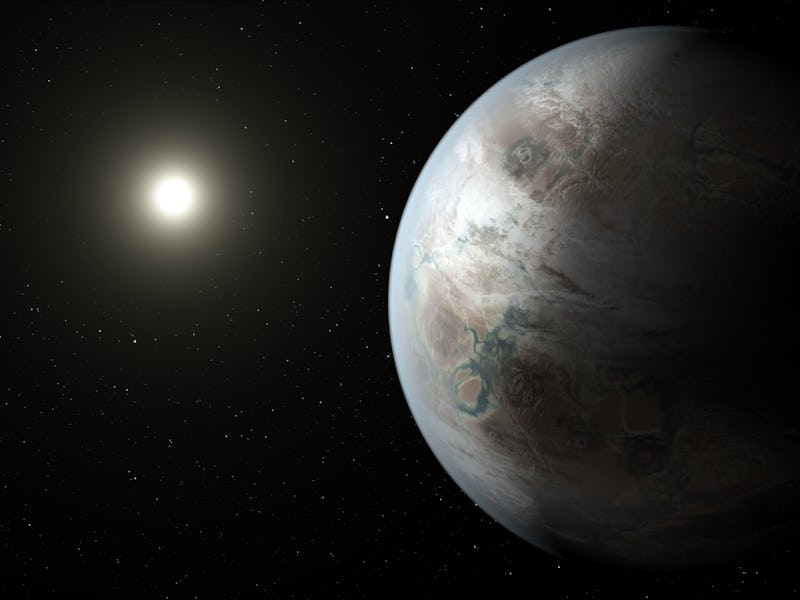UV Radiation Study Narrows Down List of Exoplanets That Could Support Life
Cyanide (although poisonous to you) is good for kickstarting extraterrestrial life too.

With over 700 million trillion planets in the observable universe, astrobiologists would really like to narrow down which exoplanets are actually worth looking at in our search for alien life. But it isn’t enough to simply look for planets in solar systems that resemble ours, scientists point out in a new Science Advances study. The search for life-supporting worlds, they write, willwill depend on depend on the ultraviolet light radiating from the stars around which those planets orbit.
UV radiation prompted a series of photochemical events in the early Earth that led to the development of life, as previous work from study co-author and Medical Research Council Laboratory of Molecular Biology chemist John Sutherland, Ph.D., has suggested. By recreating these early events using UV lamps in a lab and cross-referencing the results againsagainst the light produced by distant stars, the team, which also involved scientists from the University of Cambridge, landed on a range of stars around which Earth-like life might have most likely formed. Their results, published Wednesday, promise to advance the search for extraterrestrial life and the skincare regimens of future space travelers.
“UV light is potentially very good for having the origin of life on the early Earth, but then the UV that we think of today is actually quite damaging,” Zoe Todd, a graduate researcher at the Harvard Origins of Life Initiative who was not involved in this study, tells Inverse.
Todd’s ongoing work with astronomer and Harvard’s Origins director Dimitar Sasselov, Ph.D., has been instrumental in showing how UV light catalyzed multiple essential, life-creating reactions between hydrogen cyanide and hydrogen sulfite ions in our planet’s primordial oceans. Those reactions yielded the chemical precursors to molecules critical to biological processes here on Earth, like lipids, amino acids, and nucleotides. This process eventually led to the creation of ribonucleic acid (RNA), a compound chemically similar to DNA, which scientists believe was likely the first information-storing and -delivering compound to appear.
In the new study, the Cambridge and MRC LMB researchers recreated those chemical reactions in a lab — under UV lamps and without — to see how much UV light they need in order to occur. They then used those results to classify which star systems might have stars that radiate that amount of UV light toward their exoplanets, creating an “abiogenesis zone” suitable for creating life-producing molecules.
They determined that stars hotter than 4,400 Kelvin (about 7,460 °F) — stars as large as or larger than “orange dwarfs” or spectral-type K5 main-sequence stars — produced enough UV light to do so.
A diagram showing where confirmed exoplanets (and Earth) fall in terms of the effective temperature of their star, which defines if they are in the the UV light 'abiogenesis zone,' and the combination of heat and distance that would put the planet in the 'habitable zone' where liquid water would be present.
The new findings confirm past research conducted by Harvard theoretical physicist and cosmologist Avi Loeb, Ph.D., who is also interested in the hunt for extraterrestrial life but was not involved in the new study.
“What we concluded,” Loeb tells Inverse, “was that stars with a mass that is less than half of the mass of the sun would not produce enough ultraviolet radiation to produce the diversity of life that we find on Earth.”
“UV is very important for determining the characteristic timescale for the chemistry, and the timescale for which species become richer,” he continues.
Sutherland proposed in 2015 that carbon from meteorite impacts into the young Earth produced the hydrogen cyanide needed for these UV-catalyzed reactions. It’s an interesting hypothesis about the origins of life on Earth, but there are others.
“Not everybody subscribes to this certain origin of life scenario, which is driven by UV light on the surface of the Earth, and gets you to these things like RNA and DNA that are genetic materials and can be replicated,” says Todd.
“Other people subscribe to something called the ‘metabolism first’ hypothesis, which is basically that you get these metabolic cycles coming up first. Generally it’s postulated to have happened in deep sea hydrothermal vents — and then this is kind of an alternative theory for the origin of life.” Both theories have strengths and weaknesses, Todd says, but it’d be especially hard to locate exoplanets with hydrothermal vents from lightyears away, compared to just looking at what their sun is doing.
All of this, of course, doesn’t mean we should stop looking for life on the planets orbiting those smaller dwarf stars. Those might simply be producing life unlike anything we’ve seen in our world.
“Our imagination is limited by what we know about,” Loeb says. “And what we know about is what we find here on Earth”